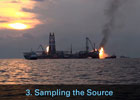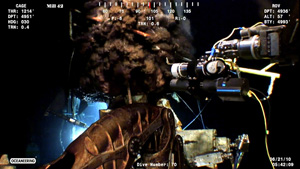Deepwater Horizon, 2010 Before scientists could calculate the amount of oil flowing into the Gulf, they needed to know the composition of the material gushing from the ruptured wellhead. To obtain this crucial piece of information, WHOI scientists used a device originally built to study hydrothermal vent fluids to capture and contain a sample of the oil and gas and then transport it back to the lab at pressure for analysis. For the past decade, researchers studying the composition of hydrothermal vent fluids have used a device called an isobaric gas tight sampler (commonly known as a Seewald sampler after its lead inventor, Jeff Seewald) to collect samples from the hot vents. Soon after the spill began, Seewald and WHOI chemist Chris Reddy realized the sampler would be the ideal device to collect a sample directly from the wellhead in order to make a more complete analysis of the material pouring into the water. When it was returned to the lab (at pressure), the sample was slowly and carefully tapped so that Reddy and others could measure the ratio of oil to gas and refine calculations of how much material was flowing into the gulf and its exact composition. From Oceanus Magazine April 20, 2011
April 20, 2011A Small Sip from a Big Gusher The impressive-sounding Isobaric Gas-tight sampler was invented at WHOI to sample fluids jetting from seafloor hydrothermal vents, but was equally adept at collecting oil and gas gushing out of the broken Deepwater Horizon wellhead. Source: Oceanus Magazine Related Multimedia Science in a Time of Crisis, Chapter 3: Sampling the Source
Science in a Time of Crisis, Chapter 3: Sampling the SourceWHOI's Response to the Deepwater Horizon Oil Spill  A Very Valuable Sample
A Very Valuable Sample Isobaric Gas-Tight Sampler
Isobaric Gas-Tight SamplerWatch video of the IGT sampler being used at hydrothermal vents in the western Pacific. » View Video (Quicktime) Related Technology Isobaric Gas-Tight Sampler
Isobaric Gas-Tight SamplerOriginally designed to sample fluids issuing from hydrothermal vents—and to keep those fluids at their native pressure—this device was used to make the only original samples of oil and gas flowing from the ruptured Deepwater Horizon well. Last updated: April 28, 2011 | ||||||||||||||||||
Copyright ©2007 Woods Hole Oceanographic Institution, All Rights Reserved, Privacy Policy. | ||||||||||||||||||


